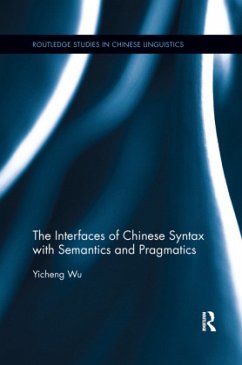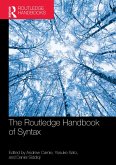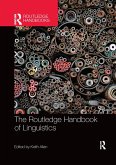Yicheng Wu
The Interfaces of Chinese Syntax with Semantics and Pragmatics
Yicheng Wu
The Interfaces of Chinese Syntax with Semantics and Pragmatics
- Broschiertes Buch
- Merkliste
- Auf die Merkliste
- Bewerten Bewerten
- Teilen
- Produkt teilen
- Produkterinnerung
- Produkterinnerung
The Interfaces of Chinese Syntax with Semantics and Pragmatics provides an in-depth exploration of a variety of interface phenomena in Chinese, a non-inflectional language, where to a large extent word order constrains its interpretation and defines its grammatical functions.
Under the Dynamic Syntax approach, which takes the incremental left-to-right processing of linguistic forms to be a fundamental part of characterizing the relation between syntactic structure and semantic interpretation, a straightforward explanation is provided. The study features detailed analysis of a range of key…mehr
Andere Kunden interessierten sich auch für
![Exhaustivity, Contrastivity, and the Semantics of Mandarin Cleft-related Structures Exhaustivity, Contrastivity, and the Semantics of Mandarin Cleft-related Structures]() Ying LiuExhaustivity, Contrastivity, and the Semantics of Mandarin Cleft-related Structures38,99 €
Ying LiuExhaustivity, Contrastivity, and the Semantics of Mandarin Cleft-related Structures38,99 €![The Routledge Handbook of Syntax The Routledge Handbook of Syntax]() The Routledge Handbook of Syntax54,99 €
The Routledge Handbook of Syntax54,99 €![The Routledge Handbook of Asian Linguistics The Routledge Handbook of Asian Linguistics]() The Routledge Handbook of Asian Linguistics227,99 €
The Routledge Handbook of Asian Linguistics227,99 €![Locality in Grammar Locality in Grammar]() Xiaoshi HuLocality in Grammar152,99 €
Xiaoshi HuLocality in Grammar152,99 €![Language Isolates Language Isolates]() Language Isolates262,99 €
Language Isolates262,99 €![Understanding Language Understanding Language]() Roger FowlerUnderstanding Language111,99 €
Roger FowlerUnderstanding Language111,99 €![The Routledge Handbook of Linguistics The Routledge Handbook of Linguistics]() The Routledge Handbook of Linguistics47,99 €
The Routledge Handbook of Linguistics47,99 €-
-
-
The Interfaces of Chinese Syntax with Semantics and Pragmatics provides an in-depth exploration of a variety of interface phenomena in Chinese, a non-inflectional language, where to a large extent word order constrains its interpretation and defines its grammatical functions.
Under the Dynamic Syntax approach, which takes the incremental left-to-right processing of linguistic forms to be a fundamental part of characterizing the relation between syntactic structure and semantic interpretation, a straightforward explanation is provided. The study features detailed analysis of a range of key grammatical constructions such as topic, passive, copular and cleft, where previous analyses were sought in pure syntactic, semantic or pragmatic terms.
Clear and straightforward throughout, The Interfaces of Chinese Syntax with Semantics and Pragmatics will be of interest to graduate students and scholars of Chinese, linguistics and cognitive science.
Under the Dynamic Syntax approach, which takes the incremental left-to-right processing of linguistic forms to be a fundamental part of characterizing the relation between syntactic structure and semantic interpretation, a straightforward explanation is provided. The study features detailed analysis of a range of key grammatical constructions such as topic, passive, copular and cleft, where previous analyses were sought in pure syntactic, semantic or pragmatic terms.
Clear and straightforward throughout, The Interfaces of Chinese Syntax with Semantics and Pragmatics will be of interest to graduate students and scholars of Chinese, linguistics and cognitive science.
Produktdetails
- Produktdetails
- Routledge Studies in Chinese Linguistics
- Verlag: Routledge / Taylor & Francis
- Seitenzahl: 230
- Englisch
- Abmessung: 12mm x 152mm x 229mm
- Gewicht: 430g
- ISBN-13: 9780367596576
- Artikelnr.: 72830584
- Herstellerkennzeichnung Die Herstellerinformationen sind derzeit nicht verfügbar.
- Routledge Studies in Chinese Linguistics
- Verlag: Routledge / Taylor & Francis
- Seitenzahl: 230
- Englisch
- Abmessung: 12mm x 152mm x 229mm
- Gewicht: 430g
- ISBN-13: 9780367596576
- Artikelnr.: 72830584
- Herstellerkennzeichnung Die Herstellerinformationen sind derzeit nicht verfügbar.
Yicheng Wu is Professor of Linguistics at the Centre for the Study of Language and Cognition, Zhejiang University, P. R. China.
Acknowledgements
Introduction
1 Chinese Syntax: A General Description
1 Introduction
2 Word order flexibility
3 Semantics in syntax
4 Pragmatics in syntax
5 Overview of the book
2 The Dynamics of Language Processing
1 A preliminary introduction
1.1 Compositionality and context-dependency
1.2 Interpretation and representation
1.3 Underspecification and resolution
2 The tools of Dynamic Syntax
2.1 Tree logic and treenode decorations
2.2 Requirements and tree growth
3 The dynamics of the parsing process *
3.1 Computational rules
3.2 Lexical actions
3.3 A basic example
3.4 Pragmatic actions
4 Simple clause structure in Chinese
5 Summary
3 The Dynamics of Verbal Underspecification in Chinese
1 Introduction
2 Previous analyses
3 A dynamic analysis
4 Summary
4 Topic Constructions
1 Introduction
2 Previous analyses
2.1 The variable analysis
2.2 The pragmatic analysis
3 A preliminary analysis
3.1 Single topic structure
3.2 Multiple topic structure
4 A dynamic analysis
4.1 English-style topic construction
4.2 Chinese-style topic construction
5 Summary
5 Passive Constructions
1 Introduction
2 Previous analyses
2.1 The Preposition Hypothesis
2.2 The Dual Function Hypothesis
2.3 The Verb Hypothesis
3 A preliminary analysis
3.1 Pragmatic voice
3.2 Left dislocation
3.3 The characterization of the canonical patterns
4 Problematic patterns
4.1 Bei construction with a retained object (BCRO)
4.2 Bei construction with an embedded ba construction (BCBC)
4.3 Bei construction with a locative patient (BCLP)
5 Summary
6 Copular Constructions
1 Introduction
2 Previous analyses
3 A preliminary analysis
4 A dynamic analysis
4.1 Predicative construction
4.2 Emphatic construction
5 Summary
7 The Cleft Construction
1 Introduction
2 Previous analyses
3 A dynamic analysis
4 Summary
8 Semantic Underspecification: Cases of Personal Pronouns
1 Introduction
2 Previous analysis of expletive ta
3 A dynamic analysis
3.1. A dynamic analysis of the typical and non-typical referential construal of ta
3.2 A dynamic analysis of the expletive construal of ta
3.3 Scope interpretation and expletive ta
3.4 Some implications
4 Summary
9 Conclusion
1 Contributions to Chinese linguistics
2 Reflections on linguistic theorizing
References
Introduction
1 Chinese Syntax: A General Description
1 Introduction
2 Word order flexibility
3 Semantics in syntax
4 Pragmatics in syntax
5 Overview of the book
2 The Dynamics of Language Processing
1 A preliminary introduction
1.1 Compositionality and context-dependency
1.2 Interpretation and representation
1.3 Underspecification and resolution
2 The tools of Dynamic Syntax
2.1 Tree logic and treenode decorations
2.2 Requirements and tree growth
3 The dynamics of the parsing process *
3.1 Computational rules
3.2 Lexical actions
3.3 A basic example
3.4 Pragmatic actions
4 Simple clause structure in Chinese
5 Summary
3 The Dynamics of Verbal Underspecification in Chinese
1 Introduction
2 Previous analyses
3 A dynamic analysis
4 Summary
4 Topic Constructions
1 Introduction
2 Previous analyses
2.1 The variable analysis
2.2 The pragmatic analysis
3 A preliminary analysis
3.1 Single topic structure
3.2 Multiple topic structure
4 A dynamic analysis
4.1 English-style topic construction
4.2 Chinese-style topic construction
5 Summary
5 Passive Constructions
1 Introduction
2 Previous analyses
2.1 The Preposition Hypothesis
2.2 The Dual Function Hypothesis
2.3 The Verb Hypothesis
3 A preliminary analysis
3.1 Pragmatic voice
3.2 Left dislocation
3.3 The characterization of the canonical patterns
4 Problematic patterns
4.1 Bei construction with a retained object (BCRO)
4.2 Bei construction with an embedded ba construction (BCBC)
4.3 Bei construction with a locative patient (BCLP)
5 Summary
6 Copular Constructions
1 Introduction
2 Previous analyses
3 A preliminary analysis
4 A dynamic analysis
4.1 Predicative construction
4.2 Emphatic construction
5 Summary
7 The Cleft Construction
1 Introduction
2 Previous analyses
3 A dynamic analysis
4 Summary
8 Semantic Underspecification: Cases of Personal Pronouns
1 Introduction
2 Previous analysis of expletive ta
3 A dynamic analysis
3.1. A dynamic analysis of the typical and non-typical referential construal of ta
3.2 A dynamic analysis of the expletive construal of ta
3.3 Scope interpretation and expletive ta
3.4 Some implications
4 Summary
9 Conclusion
1 Contributions to Chinese linguistics
2 Reflections on linguistic theorizing
References
Acknowledgements
Introduction
1 Chinese Syntax: A General Description
1 Introduction
2 Word order flexibility
3 Semantics in syntax
4 Pragmatics in syntax
5 Overview of the book
2 The Dynamics of Language Processing
1 A preliminary introduction
1.1 Compositionality and context-dependency
1.2 Interpretation and representation
1.3 Underspecification and resolution
2 The tools of Dynamic Syntax
2.1 Tree logic and treenode decorations
2.2 Requirements and tree growth
3 The dynamics of the parsing process *
3.1 Computational rules
3.2 Lexical actions
3.3 A basic example
3.4 Pragmatic actions
4 Simple clause structure in Chinese
5 Summary
3 The Dynamics of Verbal Underspecification in Chinese
1 Introduction
2 Previous analyses
3 A dynamic analysis
4 Summary
4 Topic Constructions
1 Introduction
2 Previous analyses
2.1 The variable analysis
2.2 The pragmatic analysis
3 A preliminary analysis
3.1 Single topic structure
3.2 Multiple topic structure
4 A dynamic analysis
4.1 English-style topic construction
4.2 Chinese-style topic construction
5 Summary
5 Passive Constructions
1 Introduction
2 Previous analyses
2.1 The Preposition Hypothesis
2.2 The Dual Function Hypothesis
2.3 The Verb Hypothesis
3 A preliminary analysis
3.1 Pragmatic voice
3.2 Left dislocation
3.3 The characterization of the canonical patterns
4 Problematic patterns
4.1 Bei construction with a retained object (BCRO)
4.2 Bei construction with an embedded ba construction (BCBC)
4.3 Bei construction with a locative patient (BCLP)
5 Summary
6 Copular Constructions
1 Introduction
2 Previous analyses
3 A preliminary analysis
4 A dynamic analysis
4.1 Predicative construction
4.2 Emphatic construction
5 Summary
7 The Cleft Construction
1 Introduction
2 Previous analyses
3 A dynamic analysis
4 Summary
8 Semantic Underspecification: Cases of Personal Pronouns
1 Introduction
2 Previous analysis of expletive ta
3 A dynamic analysis
3.1. A dynamic analysis of the typical and non-typical referential
construal of ta
3.2 A dynamic analysis of the expletive construal of ta
3.3 Scope interpretation and expletive ta
3.4 Some implications
4 Summary
9 Conclusion
1 Contributions to Chinese linguistics
2 Reflections on linguistic theorizing
References
Introduction
1 Chinese Syntax: A General Description
1 Introduction
2 Word order flexibility
3 Semantics in syntax
4 Pragmatics in syntax
5 Overview of the book
2 The Dynamics of Language Processing
1 A preliminary introduction
1.1 Compositionality and context-dependency
1.2 Interpretation and representation
1.3 Underspecification and resolution
2 The tools of Dynamic Syntax
2.1 Tree logic and treenode decorations
2.2 Requirements and tree growth
3 The dynamics of the parsing process *
3.1 Computational rules
3.2 Lexical actions
3.3 A basic example
3.4 Pragmatic actions
4 Simple clause structure in Chinese
5 Summary
3 The Dynamics of Verbal Underspecification in Chinese
1 Introduction
2 Previous analyses
3 A dynamic analysis
4 Summary
4 Topic Constructions
1 Introduction
2 Previous analyses
2.1 The variable analysis
2.2 The pragmatic analysis
3 A preliminary analysis
3.1 Single topic structure
3.2 Multiple topic structure
4 A dynamic analysis
4.1 English-style topic construction
4.2 Chinese-style topic construction
5 Summary
5 Passive Constructions
1 Introduction
2 Previous analyses
2.1 The Preposition Hypothesis
2.2 The Dual Function Hypothesis
2.3 The Verb Hypothesis
3 A preliminary analysis
3.1 Pragmatic voice
3.2 Left dislocation
3.3 The characterization of the canonical patterns
4 Problematic patterns
4.1 Bei construction with a retained object (BCRO)
4.2 Bei construction with an embedded ba construction (BCBC)
4.3 Bei construction with a locative patient (BCLP)
5 Summary
6 Copular Constructions
1 Introduction
2 Previous analyses
3 A preliminary analysis
4 A dynamic analysis
4.1 Predicative construction
4.2 Emphatic construction
5 Summary
7 The Cleft Construction
1 Introduction
2 Previous analyses
3 A dynamic analysis
4 Summary
8 Semantic Underspecification: Cases of Personal Pronouns
1 Introduction
2 Previous analysis of expletive ta
3 A dynamic analysis
3.1. A dynamic analysis of the typical and non-typical referential
construal of ta
3.2 A dynamic analysis of the expletive construal of ta
3.3 Scope interpretation and expletive ta
3.4 Some implications
4 Summary
9 Conclusion
1 Contributions to Chinese linguistics
2 Reflections on linguistic theorizing
References
Acknowledgements
Introduction
1 Chinese Syntax: A General Description
1 Introduction
2 Word order flexibility
3 Semantics in syntax
4 Pragmatics in syntax
5 Overview of the book
2 The Dynamics of Language Processing
1 A preliminary introduction
1.1 Compositionality and context-dependency
1.2 Interpretation and representation
1.3 Underspecification and resolution
2 The tools of Dynamic Syntax
2.1 Tree logic and treenode decorations
2.2 Requirements and tree growth
3 The dynamics of the parsing process *
3.1 Computational rules
3.2 Lexical actions
3.3 A basic example
3.4 Pragmatic actions
4 Simple clause structure in Chinese
5 Summary
3 The Dynamics of Verbal Underspecification in Chinese
1 Introduction
2 Previous analyses
3 A dynamic analysis
4 Summary
4 Topic Constructions
1 Introduction
2 Previous analyses
2.1 The variable analysis
2.2 The pragmatic analysis
3 A preliminary analysis
3.1 Single topic structure
3.2 Multiple topic structure
4 A dynamic analysis
4.1 English-style topic construction
4.2 Chinese-style topic construction
5 Summary
5 Passive Constructions
1 Introduction
2 Previous analyses
2.1 The Preposition Hypothesis
2.2 The Dual Function Hypothesis
2.3 The Verb Hypothesis
3 A preliminary analysis
3.1 Pragmatic voice
3.2 Left dislocation
3.3 The characterization of the canonical patterns
4 Problematic patterns
4.1 Bei construction with a retained object (BCRO)
4.2 Bei construction with an embedded ba construction (BCBC)
4.3 Bei construction with a locative patient (BCLP)
5 Summary
6 Copular Constructions
1 Introduction
2 Previous analyses
3 A preliminary analysis
4 A dynamic analysis
4.1 Predicative construction
4.2 Emphatic construction
5 Summary
7 The Cleft Construction
1 Introduction
2 Previous analyses
3 A dynamic analysis
4 Summary
8 Semantic Underspecification: Cases of Personal Pronouns
1 Introduction
2 Previous analysis of expletive ta
3 A dynamic analysis
3.1. A dynamic analysis of the typical and non-typical referential construal of ta
3.2 A dynamic analysis of the expletive construal of ta
3.3 Scope interpretation and expletive ta
3.4 Some implications
4 Summary
9 Conclusion
1 Contributions to Chinese linguistics
2 Reflections on linguistic theorizing
References
Introduction
1 Chinese Syntax: A General Description
1 Introduction
2 Word order flexibility
3 Semantics in syntax
4 Pragmatics in syntax
5 Overview of the book
2 The Dynamics of Language Processing
1 A preliminary introduction
1.1 Compositionality and context-dependency
1.2 Interpretation and representation
1.3 Underspecification and resolution
2 The tools of Dynamic Syntax
2.1 Tree logic and treenode decorations
2.2 Requirements and tree growth
3 The dynamics of the parsing process *
3.1 Computational rules
3.2 Lexical actions
3.3 A basic example
3.4 Pragmatic actions
4 Simple clause structure in Chinese
5 Summary
3 The Dynamics of Verbal Underspecification in Chinese
1 Introduction
2 Previous analyses
3 A dynamic analysis
4 Summary
4 Topic Constructions
1 Introduction
2 Previous analyses
2.1 The variable analysis
2.2 The pragmatic analysis
3 A preliminary analysis
3.1 Single topic structure
3.2 Multiple topic structure
4 A dynamic analysis
4.1 English-style topic construction
4.2 Chinese-style topic construction
5 Summary
5 Passive Constructions
1 Introduction
2 Previous analyses
2.1 The Preposition Hypothesis
2.2 The Dual Function Hypothesis
2.3 The Verb Hypothesis
3 A preliminary analysis
3.1 Pragmatic voice
3.2 Left dislocation
3.3 The characterization of the canonical patterns
4 Problematic patterns
4.1 Bei construction with a retained object (BCRO)
4.2 Bei construction with an embedded ba construction (BCBC)
4.3 Bei construction with a locative patient (BCLP)
5 Summary
6 Copular Constructions
1 Introduction
2 Previous analyses
3 A preliminary analysis
4 A dynamic analysis
4.1 Predicative construction
4.2 Emphatic construction
5 Summary
7 The Cleft Construction
1 Introduction
2 Previous analyses
3 A dynamic analysis
4 Summary
8 Semantic Underspecification: Cases of Personal Pronouns
1 Introduction
2 Previous analysis of expletive ta
3 A dynamic analysis
3.1. A dynamic analysis of the typical and non-typical referential construal of ta
3.2 A dynamic analysis of the expletive construal of ta
3.3 Scope interpretation and expletive ta
3.4 Some implications
4 Summary
9 Conclusion
1 Contributions to Chinese linguistics
2 Reflections on linguistic theorizing
References
Acknowledgements
Introduction
1 Chinese Syntax: A General Description
1 Introduction
2 Word order flexibility
3 Semantics in syntax
4 Pragmatics in syntax
5 Overview of the book
2 The Dynamics of Language Processing
1 A preliminary introduction
1.1 Compositionality and context-dependency
1.2 Interpretation and representation
1.3 Underspecification and resolution
2 The tools of Dynamic Syntax
2.1 Tree logic and treenode decorations
2.2 Requirements and tree growth
3 The dynamics of the parsing process *
3.1 Computational rules
3.2 Lexical actions
3.3 A basic example
3.4 Pragmatic actions
4 Simple clause structure in Chinese
5 Summary
3 The Dynamics of Verbal Underspecification in Chinese
1 Introduction
2 Previous analyses
3 A dynamic analysis
4 Summary
4 Topic Constructions
1 Introduction
2 Previous analyses
2.1 The variable analysis
2.2 The pragmatic analysis
3 A preliminary analysis
3.1 Single topic structure
3.2 Multiple topic structure
4 A dynamic analysis
4.1 English-style topic construction
4.2 Chinese-style topic construction
5 Summary
5 Passive Constructions
1 Introduction
2 Previous analyses
2.1 The Preposition Hypothesis
2.2 The Dual Function Hypothesis
2.3 The Verb Hypothesis
3 A preliminary analysis
3.1 Pragmatic voice
3.2 Left dislocation
3.3 The characterization of the canonical patterns
4 Problematic patterns
4.1 Bei construction with a retained object (BCRO)
4.2 Bei construction with an embedded ba construction (BCBC)
4.3 Bei construction with a locative patient (BCLP)
5 Summary
6 Copular Constructions
1 Introduction
2 Previous analyses
3 A preliminary analysis
4 A dynamic analysis
4.1 Predicative construction
4.2 Emphatic construction
5 Summary
7 The Cleft Construction
1 Introduction
2 Previous analyses
3 A dynamic analysis
4 Summary
8 Semantic Underspecification: Cases of Personal Pronouns
1 Introduction
2 Previous analysis of expletive ta
3 A dynamic analysis
3.1. A dynamic analysis of the typical and non-typical referential
construal of ta
3.2 A dynamic analysis of the expletive construal of ta
3.3 Scope interpretation and expletive ta
3.4 Some implications
4 Summary
9 Conclusion
1 Contributions to Chinese linguistics
2 Reflections on linguistic theorizing
References
Introduction
1 Chinese Syntax: A General Description
1 Introduction
2 Word order flexibility
3 Semantics in syntax
4 Pragmatics in syntax
5 Overview of the book
2 The Dynamics of Language Processing
1 A preliminary introduction
1.1 Compositionality and context-dependency
1.2 Interpretation and representation
1.3 Underspecification and resolution
2 The tools of Dynamic Syntax
2.1 Tree logic and treenode decorations
2.2 Requirements and tree growth
3 The dynamics of the parsing process *
3.1 Computational rules
3.2 Lexical actions
3.3 A basic example
3.4 Pragmatic actions
4 Simple clause structure in Chinese
5 Summary
3 The Dynamics of Verbal Underspecification in Chinese
1 Introduction
2 Previous analyses
3 A dynamic analysis
4 Summary
4 Topic Constructions
1 Introduction
2 Previous analyses
2.1 The variable analysis
2.2 The pragmatic analysis
3 A preliminary analysis
3.1 Single topic structure
3.2 Multiple topic structure
4 A dynamic analysis
4.1 English-style topic construction
4.2 Chinese-style topic construction
5 Summary
5 Passive Constructions
1 Introduction
2 Previous analyses
2.1 The Preposition Hypothesis
2.2 The Dual Function Hypothesis
2.3 The Verb Hypothesis
3 A preliminary analysis
3.1 Pragmatic voice
3.2 Left dislocation
3.3 The characterization of the canonical patterns
4 Problematic patterns
4.1 Bei construction with a retained object (BCRO)
4.2 Bei construction with an embedded ba construction (BCBC)
4.3 Bei construction with a locative patient (BCLP)
5 Summary
6 Copular Constructions
1 Introduction
2 Previous analyses
3 A preliminary analysis
4 A dynamic analysis
4.1 Predicative construction
4.2 Emphatic construction
5 Summary
7 The Cleft Construction
1 Introduction
2 Previous analyses
3 A dynamic analysis
4 Summary
8 Semantic Underspecification: Cases of Personal Pronouns
1 Introduction
2 Previous analysis of expletive ta
3 A dynamic analysis
3.1. A dynamic analysis of the typical and non-typical referential
construal of ta
3.2 A dynamic analysis of the expletive construal of ta
3.3 Scope interpretation and expletive ta
3.4 Some implications
4 Summary
9 Conclusion
1 Contributions to Chinese linguistics
2 Reflections on linguistic theorizing
References








